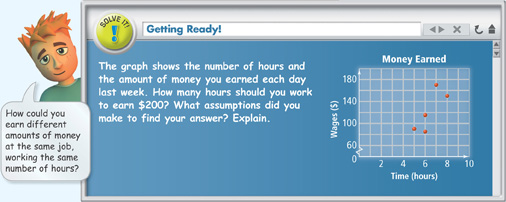2-5 Using Linear Models
Objectives
To write linear equations that model real-world data
To make predictions from linear models
 Lesson Vocabulary
Lesson Vocabulary
- scatter plot
- correlation
- line of best fit
- correlation coefficient
Graphs of data pairs for a real-world situation rarely fall in a line. Their arrangement, however, can suggest a relationship that you can model with a linear function.
Essential Understanding Sometimes it is possible to model data from a real-world situation with a linear equation. You can then use the equation to draw conclusions about the situation.
A scatter plot is a graph that relates two sets of data by plotting the data as ordered pairs. You can use a scatter plot to determine the strength of the relationship, or correlation, between data sets. The closer the data points fall along a line with positive slope,
- the stronger the linear relationship and
- the stronger the positive correlation
between the two variables.

Strong Negative Correlation

Weak Negative Correlation

No Correlation

Weak Positive Correlation

Strong Positive Correlation
Table of Contents
- 5-1 Polynomial Functions
- 5-2 Polynomials, Linear Factors, and Zeros
- 5-3 Solving Polynomial Equations
- 5-4 Dividing Polynomials
- 5-5 Theorems About Roots of Polynomial Equations
- 5-6 The Fundamental Theorem of Algebra
- 5-7 The Binomial Theorem
- 5-8 Polynomial Models in the Real World
- 5-9 Transforming Polynomial Functions





